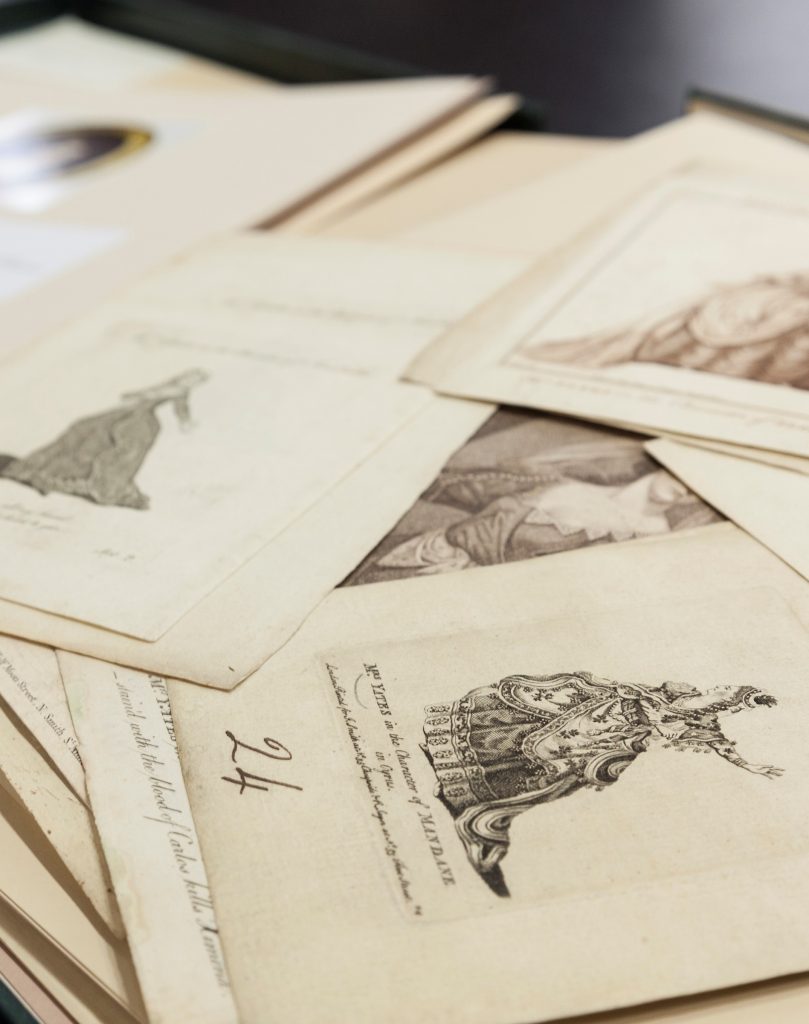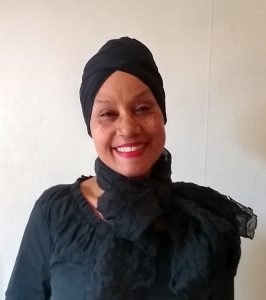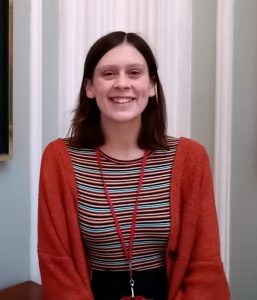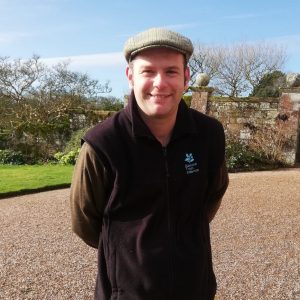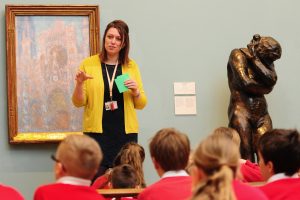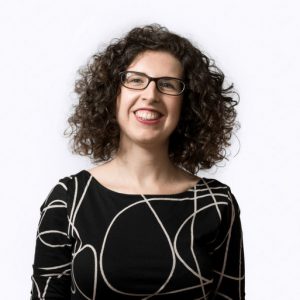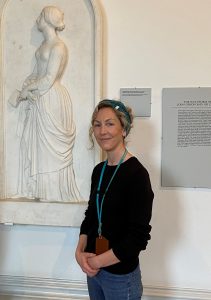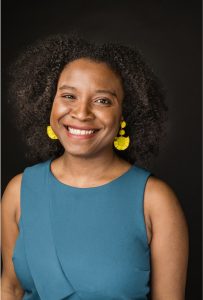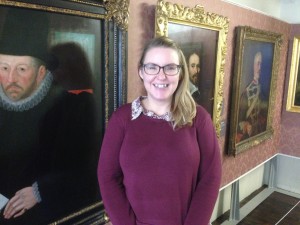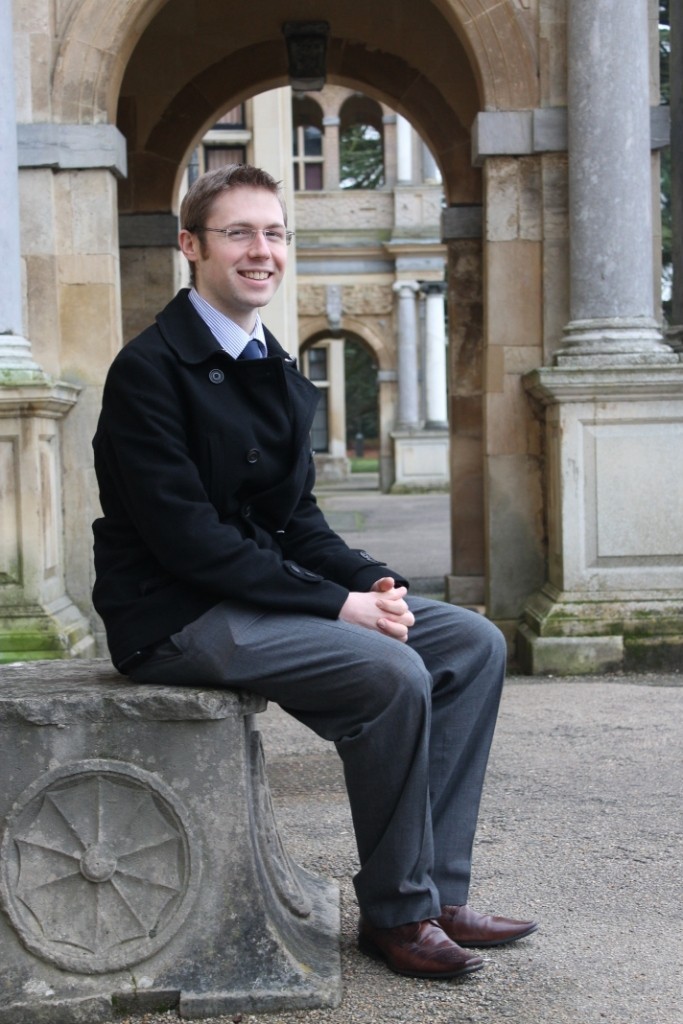Fellowships for early career collection professionals and freelancers in the UK
The Fellowship programme builds on the network’s successful Bursary programme, enabling museum professionals and freelancers to significantly enhance their portrait expertise, develop their professional network, and deliver a substantial output to benefit their home collection and its audience.
Fellowships granted in 2023:
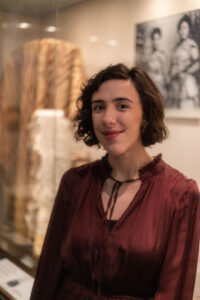
Kate Haselden
Kate Haselden, Community Participation Facilitator, National Museums Liverpool Emma Treleaven, Collections Manager, Amersham Museum
The Unnamed Black Subject: Revealing hidden narratives in William L. Windus’ The Black Boy
My project will create the first dedicated research on The Black Boy by William Lindsay Windus (1844), one of the only examples of a portrait depicting an individual Black person within National Museums Liverpool’s collection. I will examine this striking portrait of an unnamed Black child in Liverpool through three interconnected areas: the history of Liverpool’s Black community, the experiences of Black children in Britain and the Black presence in nineteenth-century British portraiture. Building on my work in community engagement, I will respond to calls from community members to highlight the agency and position of Liverpool’s Black community throughout history.
This essential research will inform the portrait’s ongoing interpretation and create opportunities for audience engagement both in the gallery and online. Delivering a series of ‘Spotlight talks’ in the museum and wider community venues, I will discuss the portrait’s significance and invite visitors to contribute their own perspectives. I will create the first digital collections record and author an updated essay revealing the complexities of the portrait’s provenance and wider historical context. Finally, I will produce a short film considering the portrait as an example of the increasingly individualistic Black presence which becomes visible in eighteenth and nineteenth-century-British portraiture. This project will eventually form the basis of the future interpretation of The Black Boy in the re-developed International Slavery Museum following the Waterfront Transformation Project.
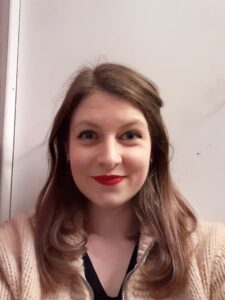
Emma Treleaven
Emma Treleaven, Collections Manager, Amersham Museum
New Perspectives through Photographic Portraits: The Duparc Family collection
My project is the cataloguing and display of the Duparc family photography collection. The Duparc’s were keen photographers, and their collection contains formal and informal family portraits tracking the entire lives of two generations of their family from the late 19th to the late 20th century. This is a rare collection of portraits tracing the growth of one middle class family living in the Amersham area over two generations, but it is also an important resource for telling the history of the Jewish faith in the local area, as the Duparc’s were members of the Liberal Jewish movement. The history of the local Jewish community is currently very under researched, and my project will help rectify this.
The researching and cataloguing of these portraits will make them accessible to the public for the first time, and enable them to be shared through an online exhibition and community events, while providing an important future research resource for the local area.
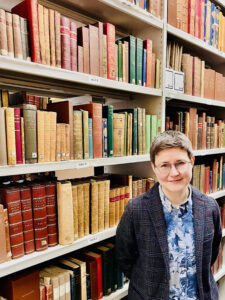
Rebecca Wade
Rebecca Wade, Novello Cowden Clarke Collection Officer, Special Collections and Galleries, University of Leeds
Taxing Knowledge: The Portrait of Richard Cobden by Emma Novello
This project investigates the portrait of the politician Richard Cobden by the artist Emma Aloysia Novello. Painted in Paris in 1861, the portrait materialises the alliance between Cobden and the Novello family that contributed to the Paper Duty Repeal Bill; part of the ultimately successful campaign against ‘Taxes on Knowledge’. Her brother (Joseph) Alfred Novello’s role in the Society for the Repeal of the Taxes on Knowledge is represented in the existing literature but Emma’s involvement has not been examined, despite her also having met and corresponded with Cobden. Her reputation has also been obscured by the artistic potential and early death of her brother Edward Petre Novello and her status as an unmarried woman. The purpose of the project is to recover the agency of Emma Novello and make visible her significance to histories of British portraiture and politics through an online exhibition and public event. By engaging in a close study of her portrait of Cobden in the context of the wider Novello Cowden Clarke Collection, we can begin to recover the relevance of her artistic and political legacy and understand her contribution to nineteenth-century culture.
Four Fellowships were granted in 2022, as follows
Dr Janet Couloute, freelance art historian and Tate guide (Fellowship in association with Tate Britain)
Renaissance Whiteness: Reimaging ‘race’ through the prism of early modern portraiture.
The central theme of my project is the notion of ‘Whiteness’ as manifested within three early modern portraits currently on display at Tate Britain: Marcus Gheeraert’s Portrait of Captain Thomas Lee (1594), Gheeraert’s Portrait of an Unknown Woman (1595) and The Cholmondeley Ladies, unknown artist (1600). Portraits that are rarely discussed as visual indexes of ‘race’, these portraits are a popular part of Tate Britain’s permanent collection, making anything new that is said about them of public interest.
I see this project as emerging from my continued interest in reframing Western art history and questioning art historic canons that perceive the early modern period as pre-racial and therefore having little relevance to modern day debates on white supremacy and colonial inheritance. Using an interdisciplinary approach that applies art history, the history of ‘race’ and early modern anatomies of skin, together with observations garnered from visitor and gallery staff. I will produce revised captions accompanying each of my chosen portraits. I will design a more expansive summary text of each portrait, together with an audio interpretation of the works to be included on Tate’s website. Using my experience as a gallery guide and art historian, I will also design and deliver a series of guided discussions on the portraits to gallery visitors.
Ellen Embleton, Picture Curator, The Royal Society
Seeing clearly: Establishing the ‘Unknowns’ of four 17th century portraits
This project seeks to examine two portrait pairs from the late 17th century in the Royal Society collection, depicting former Fellows Abraham Hill (1633-1721) and Cyril Wyche (c.1632-1707) and (perhaps) their wives. We have limited provenance information on either portrait set, and while we know a little about both male sitters, including that they both held administrative positions in colonial affairs, the identities of the women are not certain, and neither pairing has a definite artist.
This project proposes undertaking essential research in collections that hold relevant material on the Hill and Wyche families to gain provenance, biographical and contextual information on these portraits. With this, we plan to bolster the display and interpretive material we hold on these portrait pairs, and create exciting, new points of access to them via digitisation and their upload to various online resources. In doing so, we hope to better address our sitters’ links to colonial institutions of the time and move two female sitters from the realm of the unknown into the realm of the known.
Robert Meakings, Collections and House Officer, Killerton House, Exeter (National Trust)
Portraits, Patronage and Politics: The Aclands in Oil
With over 80 portraits of the Acland family covering more than 400 years of history, captured by some of the greatest artists of the day, the portrait collection at Killerton is the most significant part of our collection and our most powerful tool for understanding the past and bringing it to life for our visitors.
Focusing on four key portraits, this project will explore the relationship between the artist and the sitter. It will consider how and why the artist came to paint the portrait and it will assess how the Acland portrait collection documents and communicates the families’ political beliefs and values.
I hope that this project will shine a light on the importance of the Killerton portrait collection and highlight how it can be used to trace broader artistic and social trends. Research outputs will include written materials and improved records for everyday use, a collection of short films, enhanced connections with relevant properties and archives, and a programme of talks and tours.
To watch the film series produced as part of this project, please visit our Films page.
Stephanie Roberts, freelance curator (Fellowship in association with National Museum Cardiff)
The Blind Harpists: another look
Around two million people in Britain are blind or vision impaired, but our museums and galleries still have a long way to go to address their needs. Although important work is being done across the sector, museums and galleries as a whole are not doing enough to meet the access needs of people who are blind or vision impaired. They are still underrepresented in visitor demographics, and are rarely to be seen on our gallery walls. During my fellowship I will research a small group of historic portraits of blind harpists at National Museum Cardiff, and use this to engage a small group of vision-impaired people in conversations around the representation of blindness in art, and how this intersects with their lived experience.
The portraits of blind harpists – which include two oil paintings of John Parry (Pari Ddall), a musical celebrity of the 18th century – are popular with visitors. But the interpretation around them usually presents their blindness as a curiosity or novelty. No attempt has been made to root the images in the social and cultural understanding of blindness of their time; nor has there been any attempt to find out what the portraits might mean to blind and vision-impaired visitors today. This project hopes to address this. It aims to take another look at the portraits, from the viewpoint of people who understand the complexities of visibility and sight, and what it means to be seen – or not seen – by our cultural institutions. The outputs will include two workshops for people with vision impairment; updated interpretation for the portraits; new audio descriptions and digital content for the museum’s website. The project is conceived as way of using new research to create an opportunity for participants to share experiences and engage with a cultural experience that is not usually accessible to them.
To watch the film produced as part of this project, please visit our Films page.
Two Fellowships focused on decolonisation activity were granted in 2021, with specialist mentoring support, as follows (with thanks to Art Fund)
Dr Laura Claveria, Assistant Curator of Fine Art (Works on Paper), Leeds Art Gallery
From ‘A Negress’ to ‘Lady in a Hat’: Revisiting Phil May’s Work from a Decolonising Perspective
This project aims to re-examine a coloured chalk drawing by the Leeds-born artist Phil May (1864–1903) originally titled ‘A Negress’ (1879-1903) from three different perspectives: the sitter, the artist and the curator.
Firstly, the project sets out to shed light on the sitter’s identity, putting an end to her anonymity and the current racist reduction of her individuality. Secondly, the project seeks to research the artist’s life and work with the aim of raising fundamental questions around the context of the artwork’s production to help me better understand the artist’s approach to this particular subject. Finally, I want to unpick any racist curatorial practices that may have taken place when collecting, accessioning or interpreting this work. In particular, I would like to contextualise and address the original title, proposing a new one.
As a result of this Fellowship, a highlighted display of Phil May’s ‘Lady in a Hat’ (working title) with new audio interpretation will be created and a series of workshops for key youth and community groups will be delivered.
Read more about Laura’s research project here >>
Alex Patterson, Assistant Curator of Fine Art, National Museums Liverpool
The Colonial Legacies of the Liverpool Sandbach Family
My research will focus on Liverpool’s Sandbach family and their involvement in the transatlantic slave trade. The Sandbachs were shipowners, brokers, merchants and plantation owners, exporting sugar, coffee, molasses and rum from the West Indies. Their business Sandbach, Tinne & Company, and its associate firms in Liverpool and Glasgow, all relied on slavery and later indentured labour to operate lucratively. The Walker Art Gallery has three relief portraits of members of the Sandbach family by (and attributed to) leading sculptor John Gibson (1790–1866) which are currently on display. In addition, the family previously owned important works in the collection such as Henry Wadsworth Longfellow by the African American sculptress Edmonia Lewis (1844–1907). Generous patrons of the arts, particularly sculpture, and leading citizens of Liverpool, the Sandbach portraits have been displayed unquestioningly for over a century.
Through in-depth research of their business interests and their patronage of the arts I will confront the Sandbachs’ ties to slavery. A comprehensive review of decolonising practices across the sector will enable me to interrogate if these portraits should remain on display. Based on my findings I will develop a new strategy for the display and interpretation of the portraits, in collaboration with a community steering group and through consultation with the Fellowship mentor.
Read more about Alex’s Sandbach Research Project here >>
Fellowship mentor Christelle Pellecuer
Christelle is the Founder and Creative Director at Razana Afrika, a community organisation using African history and culture to inspire and transform communities and engage young people to improve their motivations and achievements. As part of this work, Christelle curated an exhibition called “African Queen”, which looked at the story and portrait of 18 historical and legendary Africans queens whose stories are not widely known and told. Christelle also has experience of working in the area of decolonising museums and education.
Five Professional Research Fellowships were granted in 2019, as follows
Anna Maria Barry, Museum Research Assistant, Royal College of Music Museum
Musical Portraits in Bohemian London: 1870-1930
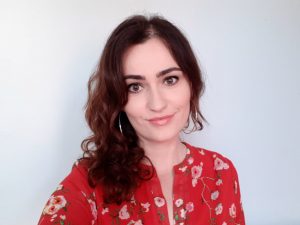
Anna Maria Barry, Museum Research Assistant, Royal College of Music Museum
My project will explore a bohemian social set that came together in London during the period 1870 to 1930. Its members included both artists and musicians. The former group counted Edward Burne-Jones, John Singer Sargent, George Frederic Watts and Lawrence Alma-Tadema amongst its members. In the latter group were celebrity pianists Jan Paderewski and Jacques Blumenthal, baritone Sir George Henschel and conductor Lionel Benson. Members of these groups frequently collaborated, with artists often painting their musical friends. Many of these works have survived at the Royal College of Music Museum, which looks after one of the world’s largest collections of musical portraits.
Taking a small group of these portraits as its focus, this project will research the stories of these paintings and the relationships between their artists and sitters. This will reveal the significant and surprising ways in which members of this important social circle collaborated. Research will be conducted internationally, at the National Museum in Warsaw and the National Library of Scotland. My discoveries will be disseminated through an ambitious programme of engagement activities, including two publications, an interactive digital exhibition and a portrait-making activity for children. A recreation of a bohemian soirée will also be held at the Royal College of Music, featuring performances from some of its students.
Gemma Haigh, Curatorial Assistant, Guildford Museum
The Significance of being Female: Female Sitters in Portraits by John Russell in the Guildford Heritage Services Collection
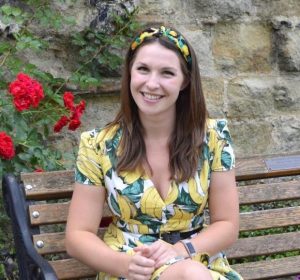
Gemma Haigh, Curatorial Assistant, Guildford Museum
With a nationally significant collection of over 35 original works in the Guildford collection by eighteenth century artist, John Russell, I will be using this opportunity to research twenty of his female portraits. They are mostly pastels but I will also be examining two oil paintings during the course of the project.
It is my hope that exploring the identities of the female sitters will provide new insight into an under-represented section of eighteenth century society. I also hope that the research will tell us more about Russell as an artist, show us how Russell interacted with women and shed light on his attitudes towards them. I hope that the new information will recommend Guildford as a centre of excellence for the study of John Russell in the future.
Amongst other things, the results of this project will be a display at Guildford House Gallery in 2021 that will celebrate John Russell’s work and an accompanying booklet with information about featured portraits. We will also produce a video to be displayed at the Museum and Gallery, which explains the special preventive conservation needs of pastel pictures (below).
Imogen Tedbury, Assistant Curator, Royal Holloway, University of London
Portraying Professional Women: Portraits of Principals and Pioneers at Royal Holloway and Bedford New College
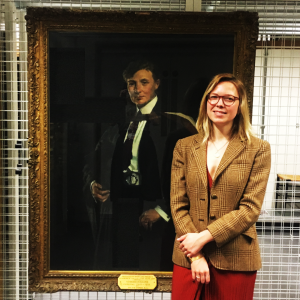 I am researching the remarkable portraits of women principals, professors and academic pioneers from the Royal Holloway and Bedford New College art collections https://www.royalholloway.ac.uk/about-us/art-collections/
I am researching the remarkable portraits of women principals, professors and academic pioneers from the Royal Holloway and Bedford New College art collections https://www.royalholloway.ac.uk/about-us/art-collections/
Royal Holloway College and Bedford College were among the first women’s higher education institutions in the UK. Both colleges commissioned portraits of their female leaders from famous society portraitists, including Sir William Orpen, Philip de Laszlo and Francis Dodd. This unique collection of portraits, formed when the two colleges merged in 1985, attest to the colleges’ pride in their principals. They also challenge assumptions about women’s portraiture in the late 19th and early 20th century. I will be researching the portraits’ commission, artists’ practice, and their contemporary reception, display and reproduction, in order to trace intersections between the professionalization of women and modern British portraiture. Research outputs include a new permanent display of the portraits in College, an accompanying catalogue available in print and online, and three short films (see below).
Gina Warburton, Exhibitions & Collections Assistant, Bury Art Gallery & Sculpture Centre
The Walker Family: Identity and Philanthropy
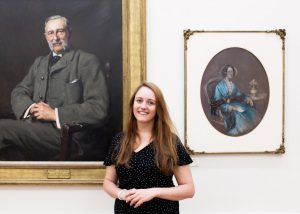
Gina Warburton, Exhibitions & Collections Assistant, Bury Art Museum & Sculpture Centre
For this project I shall be researching three newly acquired portraits in Bury Art Museum’s collection by Louis-Pierre Spindler which depict Colonel Oliver Ormerod Walker and members of his family. Oliver Walker was a local benefactor, enthusiast and driver of Bury Art Museum’s establishment and the whole family was integral to Bury’s history and local community.
Gifted by direct descendants, I shall use this vital link with the family to interview and record their memories of these paintings and take photographic portraits of them; continuing the tradition of portraiture within the family.
The research will culminate in an exhibition, creative interpretation booklet and the commissioning of new work three contemporary artists. The artists will use this research as inspiration to create new artworks focusing on portraiture – identity, perception, symbolism, philanthropy and patronage – which will be shown during a pop-up event for the local community, volunteers and the direct family; all celebrating a shared heritage.
Miranda Winchcombe-Young, Project Officer (Collections), Kingston Lacy, National Trust, Dorset
A closer look: The Kingston Lacy Bone enamels
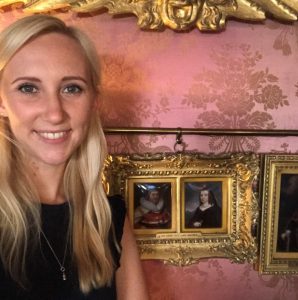
Miranda Winchcombe-Young, Project Officer (Collections), National Trust, Kingston Lacy
My research will focus on a set of Henry Bone enamel portraits in the collection at Kingston Lacy, bought by William John Bankes in the 1830s.
The enamels mostly portray Elizabethan courtiers and are copies of original sixteenth and seventeenth century portraits. Research will help to understand William’s purchase of the enamels and will map them with their preparatory sketches and original portraits, considering their influence on contemporary views of the sixteenth and seventeenth centuries. A temporary exhibition will focus on a select number of the enamels, where visitors will be able to see them up close, alongside refreshed interpretation.
Three Professional Research Fellowships were granted in 2017, as follows
Leeanne Westwood, Museum Curator at Valence House Museum in Dagenham
Leeanne is researching the remarkable collection of Fanshawe family portraits, ranging in date from 1560 to 1940, at Valence House Museum. Artists represented include Peter Lely, Marcus Gheeraerts the younger, and Mary Beale. Of particular interest is the presence of contemporary seventeenth-century studio copies of portraits, which can be related to examples in other private and public collections. Leeanne will map these Fanshawe portraits, gaining greater insights into how the family commissioned and displayed replicas.
This research will be presented in a temporary exhibition at Valence House Museum in spring 2018, with accompanying visitor interpretation and booklet.
Catherine Shanahan, Collections Officer at Rugby Art Gallery and Museum
Catherine is researching the photographic archive of the Redding studio run by Graham Wiseman in Rugby between 1958 and 1972.
Wiseman’s collection of some 25,000 acetate and glass plate negatives record the changing demographics of the town, as economic opportunities attracted migrants from Asia, the Caribbean, and elsewhere. Catherine will identify ten portraits from the collection to be the subject of intensive research, covering the sitters’ biographies and their communities. Her research will also incorporate best practice guidelines around the storage, display, handling, and digitisation of photographic media. Intended outputs include oral recordings with sitters, interpretation material for the Art Gallery and Museum website, and temporary displays for in-gallery use and at community engagement events.
Tom Boggis, Senior Curator at the Holburne Museum in Bath
Tom’s research is derived from the portrait of Catherine Cussans (1753-1834) by John Hoppner in the Holburne collection.
Cussans was the paternal aunt of Sir William Holburne and Sir William’s collection forms the founding core of the museum. Biographical research is intended to uncover more about Cussans’ own collecting activities, the sources of her wealth which eventually helped to purchase the museum’s home on Great Pulteney Street, and the influence she had in developing her nephew’s collecting interests. Tom will also be researching Hoppner’s practice and oeuvre, in order to reassess his contemporary reception by patrons, critics, and the wider artistic community. The various outputs of this research include new content for the museum’s website, volunteer training, and a revised children’s trail.
Three Professional Research Fellowships were granted in 2016, as follows
Professional Learning Fellow: Su Hepburn, Senior Learning Officer, Royal Pavilion & Museums, Brighton
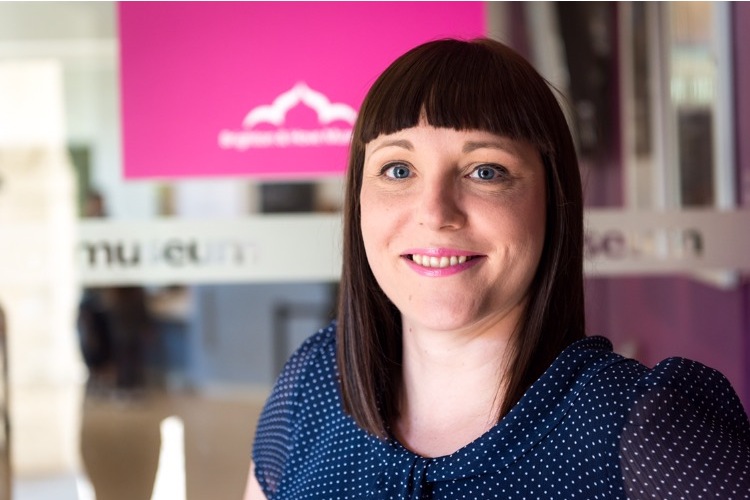
Su Hepburn, Senior Learning Officer, Royal Pavilion & Museums, Brighton. Professional Learning Fellow 2016/17.
Su researched the life of Frances Garnet Wolseley, Viscountess Wolseley (1872-1936) and her portrait by Julian Russell Story dated 1884.
Wolseley trained female students in the practicalities of garden design and management, formally establishing Glynde College for Lady Gardeners in 1907 and publishing Gardening for Women the following year. She was a life-long advocate of market co-operatives, smallholdings, and the revival of rural industries. Local and national archives, especially the Brighton & Hove Libraries’ Rare Books collection, were consulted to better understand the sitter’s personal and professional biography. This research informed a free online teachers’ resource which enables teachers to explore this portrait and the language of portraiture with their students.
Professional Partnership Fellows: Dr Kate Noble, Education Officer, and Lucy Shipp, Learning Associate – Widening Participation and Arts Award, The Fitzwilliam Museum, Cambridge
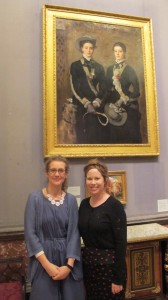
Dr Kate Noble, Education Officer, and Lucy Sercombe, Learning Associate, The Fitzwilliam Museum, Cambridge. Professional Research Fellows 2016/17.
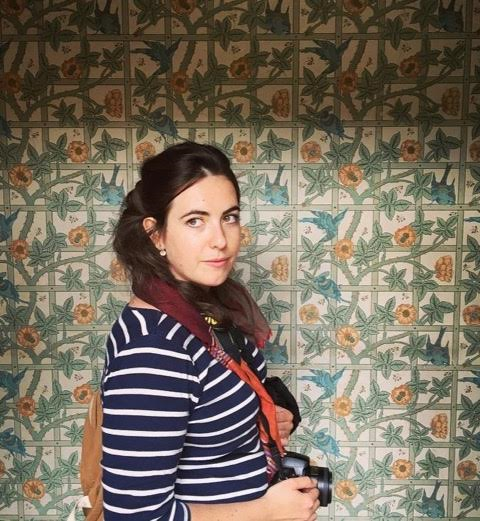
Lucy Shipp, Learning Associate – Widening Participation and Arts Award, Fitzwilliam Museum, Cambridge. Professional Research Fellows 2016/17.
Kate Noble began this Fellowship with colleague Lucy Sercombe in spring 2016, and after the latter’s departure from the Fitzwilliam Museum in late summer 2016, Kate was joined by Lucy Shipp to complete the Fellowship project.
Kate and Lucy researched the portrait The Twins, Kate and Grace Hoare by John Everett Millais (1829-96), oil on canvas, 1876.
Their research focused on the biographies of the sitters and their contemporary social history and private artistic activities. A further strand of research sought to situate the portrait within Millais’s oeuvre. Anticipated outputs include a short film made by the Fellows, their Fitzwilliam colleagues, and local A’ Level students interpreting the portrait, as well as learning material for teachers and group leaders to use in order to encourage engagement with Victorian portraiture at the museum.
Professional Research Fellow: Laura Millward, Collections Assistant, The Stanley & Audrey Burton Gallery, University of Leeds
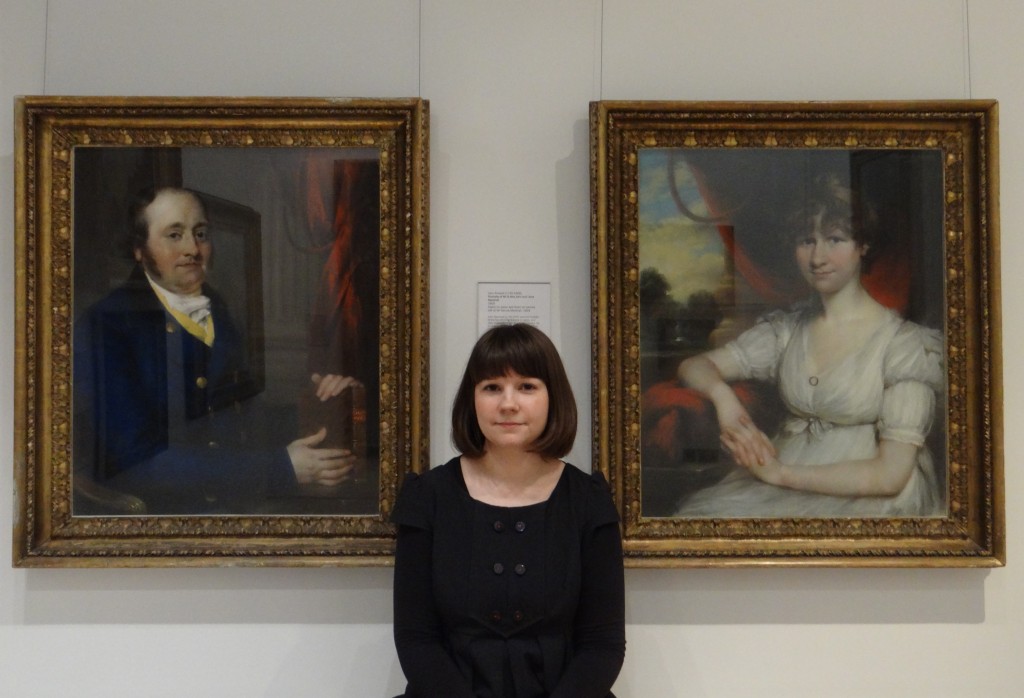
Laura Millward, Collections Assistant, The Stanley & Audrey Burton Gallery, University of Leeds. Professional Research Fellow 2016/17.
Laura researched the pastel portraits of John and Jane Marshall by John Russell, dated 1802.
John Marshall was a successful Leeds industrialist who campaigned for the foundation of a university in the city, and was involved with other public philanthropic causes. His wife Jane was a friend and correspondent of the author Dorothy Wordsworth, sister of William. Laura explored their biographies, social and professional milieu in Leeds, and connections with the portraitist John Russell (1745-1806). Outputs include new in-gallery interpretation and a visitor resource mapping the Marshalls’ contributions to the economic and social life of Leeds.

